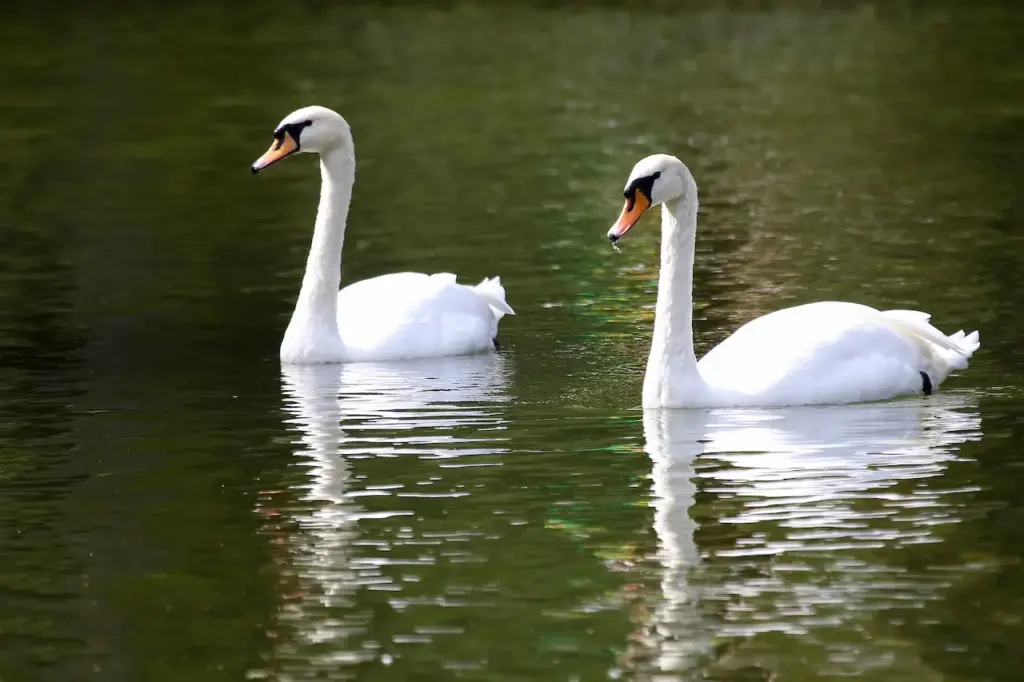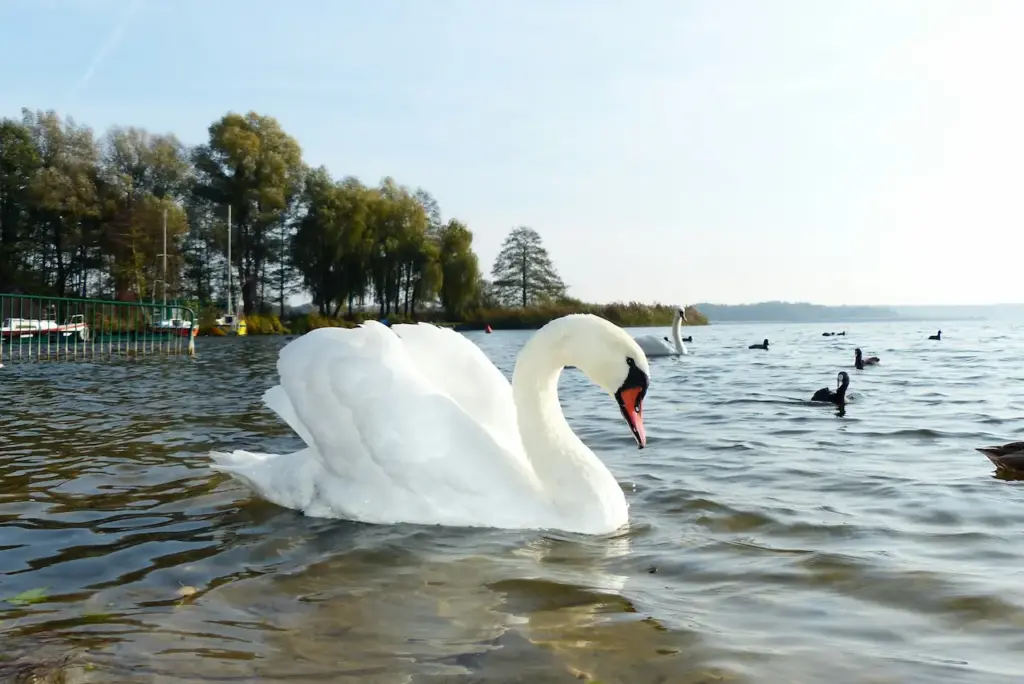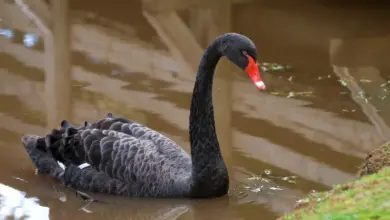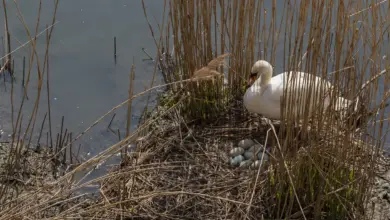Swans (genus Cygnus) belong to the Anatidae family, which also includes geese and ducks.
There are six to seven species of swan in the genus Cygnus – which likely evolved in Europe or western Eurasia during the Miocene, spreading all over the Northern Hemisphere until the Pliocene.

Swans: Bird Genus Cygnus
The Coscoroba Swan – from South America – is no longer considered a true swan. It is believed to be closely related to geese and shelducks.
The male is called a “cob” – from Middle English cobbe (leader of a group); the female “pen,” and their chicks are known as “cygnets” – from the Latin word for swan, Cygnus.
Swan pairs typically bond for life and pairs stay together throughout the year, including moving together in migratory populations.
However, it has been observed that some of them switch mates over their lifetimes, particularly after nesting failures, and some that lost their mate did not mate again.
The “divorce rate” is estimated to be about 6%. Additionally, studies found that around a third of all broods exhibit extra-pair paternity.
If a male pairs up with another younger female, she will typically join him on his territory. If he pairs up with an older female, he will go to hers.
If a female loses her mate, she will usually pair up quickly – usually choosing a younger male. Bonded pairs tend to remain together year-round; however, outside the breeding season, they are highly social and often congregate with large numbers of other swans.
During the breeding season, pairs will, however, aggressively defend their territories.
Typical swans perform what is commonly referred to as a “triumph ceremony” referencing the male’s performance after successfully challenging a rival suitor. This ceremony involves posturing and calling.
Physical differences between ducks, swans, and geese:
Sometimes, it is easy to confuse geese and the related ducks and swans, and the groupings are in some cases unclear and disputed. However, speaking in general terms, size is usually a method of identification: swans tend to be larger than true geese and ducks are usually smaller.
Swans have longer necks than geese, and geese have necks that are shorter than the body. Geese have longer necks than most duck species.
Description
The swans are among the largest flying birds.
The largest species, including the mute swan, trumpeter swan, and whooper swan, can reach a length of over 1.5 m (60 inches) and weigh over 15 kg (33 pounds). Their wingspans can be almost 3 m (10 ft). Compared to the closely related geese they are much larger and have proportionally larger feet and necks. They also have a patch of unfeathered skin between the eyes and bill in adults. The sexes are alike in plumage, but males are generally bigger and heavier than females.
Swans occurring in the Northern Hemisphere have white plumage, while those found in the Southern Hemisphere have black and white plumage.

The Australian Black Swan (Cygnus atratus) is completely black except for the white flight feathers on its wings. It has been noted that the Australian black swan only swims with one leg, tucking the other leg above its tail. The reason for this may be that the swan can more easily change direction when swimming on the surface of the water, if needed to escape an oncoming predator or to more quickly get to food.
The legs of swans are mostly dark black – except two South American species have flesh-coloured legs.
Beak colorations range from entirely black bills to black with varying amounts of yellow, or patterned red and black. The Mute Swan and Black-necked Swan have a noticeable knob at the base of the bill on the upper beak.
Distribution and Movements
Four (or five) species occur in the Northern Hemisphere, one species is found in Australia and New Zealand and one species is native in southern South America.
The swans rarely occur in the tropics and are absent from tropical Asia, Central America, northern South America and the entirety of Africa.
The Mute Swan has been introduced to North America, Australia and New Zealand.
Migration:
Several species are migratory or partly migratory, while some populations are resident..
- The Mute Swan is a partial migrant, being resident over areas of Western Europe but wholly migratory in Eastern Europe and Asia.
- The Whooper Swans, Tundra Swans, and the Trumpeter Swans are fully migratory.
- Evidence suggests that the Black-necked Swan is migratory over part of its range.
Taxonomy
Genus Cygnus
Subgenus Cygnus
- Mute Swan, Cygnus olor, is An Eurasian species found at lower latitudes than the Whooper Swan and Bewick’s Swan across Europe into southern Russia, China and the Russian Maritimes. This species has been introduced into the United States and is regionally quite common.
Subgenus Chenopis
- Black Swan, Cygnus atratus of Australia, and introduced in New Zealand.
- New Zealand Swan, Cygnus atratus sumnerensis, extinct subspecies – formerly found in New Zealand and the Chatham Islands.
Subgenus Sthenelides
- Black-necked Swan, Cygnus melancoryphus of South America.
Subgenus Olor
- Whooper Swan, Cygnus cygnus breeds in Iceland and subarctic Europe and Asia, migrating to temperate Europe and Asia in winter.
- Trumpeter Swan, Cygnus buccinator is the largest North American swan. Very similar to the Whooper Swan (and sometimes treated as a subspecies of it), it was hunted almost to extinction but has since recovered.
- Tundra Swan, Cygnus columbianus is a small swan which breeds on the North American tundra, further north than the Trumpeter Swan. It winters in the USA.
- Bewick’s Swan, Cygnus (columbianus) bewickii is the Eurasian form that migrates from Arctic Russia to western Europe and eastern Asia (China, Japan) in winter. It is often considered a subspecies of C. columbianus, creating the species Tundra Swan.

Diet / Feeding:
What they eat …
Swans feed primarily on aquatic plants; but they also eat grain, grasses and crop foods, such as wheat, potatoes and carrots – especially in the winter when other food sources aren’t readily available.
Only young cygnets (immature swans) eat aquatic insects and crustaceans, as they have a higher requirement for protein than the adults. As they get older, their diet changes over to a plant diet, which includes aquatic vegetation and roots.
How they eat …
In shallow water, Swans may use their strong webbed feet to dig into submerged mud and, like mallards, they tip up – plunging the head and neck underwater – to expose and feed on roots, shoots and tubers.
Cygnets feed on invertebrates and aquatic vegetation stirred up by their foraging parents. Ducks and other water birds also often follow swans to forage on exposed plant matter and aquatic insects.,
Their long necks give them an advantage over the short-necked ducks, as they can feed in deeper waters than geese or ducks. They can feed in waters that are up to 4 feet (1.2 meters) deep by uprooting plants and snapping off the leaves and stems of plants growing underwater.
Swans also forage by swimming picking up plant material from the water’s surface or water’s edge. On land, they feed on grains and grasses.
Calls / Vocalizations
Their calls consist of loud, deep, sonorous, trumpet-like honking sounds, as well as peeps, hisses and gurgles.
Their loud calls carry for a great distance.
Lifespan / Age
Swans are known to live 20 to 30 years. Swans form pair bonds when they are two to four years old and remain bonded for life.
The first nesting usually occurs when they are 4 or 5 years old.


